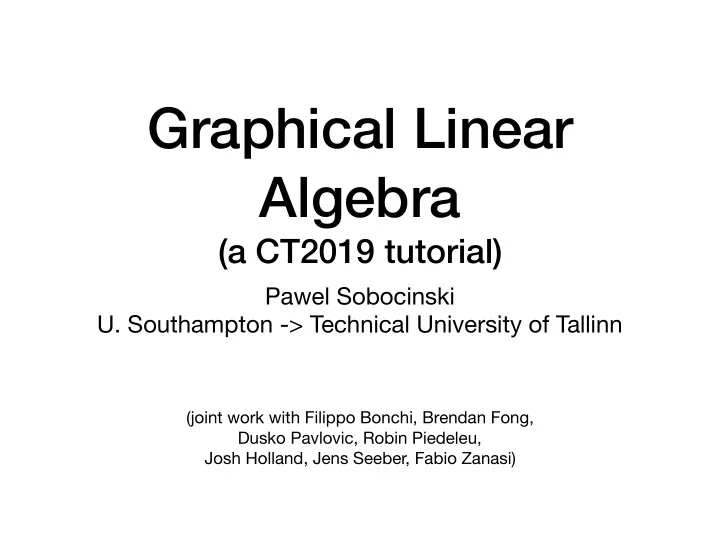

Graphical Linear Algebra (a CT2019 tutorial) Pawel Sobocinski U. Southampton -> Technical University of Tallinn (joint work with Filippo Bonchi, Brendan Fong, Dusko Pavlovic, Robin Piedeleu, Josh Holland, Jens Seeber, Fabio Zanasi)
310 The two spans are pictured thus: x x\ I x x / ~x ex Technically, r 1 and e are the unit and counit of the self-dual compact-closed structure on Span(Graph). It will become clear that their role in the context Mathematics of Open Systems of this paper is to permit a feedback operation on distributed systems. The correspondence between constants and operations, and the geometric representations given above, result in the fact that expressions in the algebra have corresponding circuit or system diagrams. We illustrate this by an example. 2.3 Example. Given spans S : X --+ X x X, C : X -+ I, the expression rjx; (S| (C|174 (S| (C|174 (S| (C|174 has system diagram: Fq rq rq x S S S \ j \ (Shannon 1942; Baez and Erbele 2014; t l T t l t T l (Katis, Sabadini, Walters 1996) Bonchi, S., Zanasi 2014) S| C|174 SQ1 C|174 S| C|174 e We have indicated the correspondence between parts of the expression and of the diagram using arrows. This diagram might be (with specific interpretation 8 Ω 6 Ω of the components S (server) and C (client)) a specification of a simple token ring. 1 1 Remark. The reader may have noticed that apart from the fact that wires are distin- guished as appearing on the left or right of components we have not indicated an orientation on the wires, by placing for example an arrowhead. The reason + – 12V is that in this algebra no such orientation is possible, and this will be reflected later in discussing concurrent systems by the fact that at this level of abstraction wires represent input/output, and not either input or output channels. 2 4 Ω (Baez, Coya, Rebro 2017; (S 2010, Bonchi, Holland, Piedeleu, S. Zanasi 2019) Coya 2018; Bonchi, Piedeleu, S., Zanasi 2019) • components with open terminals • arrows of some (symmetric) monoidal category • monoidal functor Syntax → Semantics • relational semantics as opposed to functional semantics
Plan composing props interacting Hopf algebras graphical linear algebra in action cartesian bicategories and Frobenius theories generating functions and signal flow graphs graphical a ffi ne algebra and non-passive electrical circuits
Props (Mac Lane 1965, Lack 2004) • symmetric strict monoidal categories where 1. objects are natural numbers and 2. m ⊗ n := m+n • morphisms of props = identity-on-objects symmetric strict monoidal functors • examples • P - arrows m to n are permutations from {1,…,m} to {1,…,n} (empty if m ≠ n) • F - arrows m to n are functions from {1,…,m} to {1,…,n} • any Lawvere theory • Rel X - arrows m to n are relations from X m to X n • LinRel k - arrows n to n are linear relations from k m to k n
Presentations of Props (Lack 2004) • props can be used as coat hangers for algebraic structure • example : the prop of commutative monoids Cm = = = • observation : Cm ≅ F , to give a string diagram m → n in Cm is to give a function {1,…m} → {1,…,n}
Composing props - Intuition Green prop P Purple prop Q P Q When can we understand P;Q as a prop? λ Q P P Q P λ Q P Q Q P P Q P Q
Composing Props - A Rough Sketch (Lack 2004) • recall (Street 1972): monads as arrows of a 2-category • mental gymnastics : category = monad in Span( Set ) • prop = monad in Prof( Mon ) on object P • now, given two props R , S , we can compose them • to make sense of the composite as a monad (i.e. a prop) we need a distributive law
Example - Composing with = = = = = = = = = = = = = = = = = = • ie. we need to turn a cospan of functions n m 2 m 1 into a span of functions n m 1 m 2 in a way that satisfies the requirements of distributive laws • taking the pullback in F works!
<latexit sha1_base64="HmxjqitL2zUdH0doRVkMH+vAkzk=">ACAHicbVDLSsNAFJ34rPVdelmsAgupCRV0GXBjcsK9gFtKJPJtB06MwkzN0I3fgBbvUT3Ilb/8Qv8DectFnY1gMXDufcy73BLHgBlz321lb39jc2i7tlHf39g8OK0fHbRMlmrIWjUSkuwExTHDFWsBsG6sGZGBYJ1gcpf7nSemDY/UI6Qx8yUZKT7klEAu8XDgDipVt+bOgFeJV5AqKtAcVH76YUQTyRQYzpeW4MfkY0cCrYtNxPDIsJnZAR61mqiGTGz2a3TvG5VUI8jLQtBXim/p3IiDQmlYHtlATGZtnLxf+8XgLDWz/jKk6AKTpfNEwEhgjnj+OQa0ZBpJYQqrm9FdMx0YSCjWdhiwFJdKrDqU3GW85hlbTrNe+qVn+4rjYui4xK6BSdoQvkoRvUQPeoiVqIojF6Qa/ozXl23p0P53PeuYUMydoAc7XL9U+l0=</latexit> ! ! <latexit sha1_base64="HmxjqitL2zUdH0doRVkMH+vAkzk=">ACAHicbVDLSsNAFJ34rPVdelmsAgupCRV0GXBjcsK9gFtKJPJtB06MwkzN0I3fgBbvUT3Ilb/8Qv8DectFnY1gMXDufcy73BLHgBlz321lb39jc2i7tlHf39g8OK0fHbRMlmrIWjUSkuwExTHDFWsBsG6sGZGBYJ1gcpf7nSemDY/UI6Qx8yUZKT7klEAu8XDgDipVt+bOgFeJV5AqKtAcVH76YUQTyRQYzpeW4MfkY0cCrYtNxPDIsJnZAR61mqiGTGz2a3TvG5VUI8jLQtBXim/p3IiDQmlYHtlATGZtnLxf+8XgLDWz/jKk6AKTpfNEwEhgjnj+OQa0ZBpJYQqrm9FdMx0YSCjWdhiwFJdKrDqU3GW85hlbTrNe+qVn+4rjYui4xK6BSdoQvkoRvUQPeoiVqIojF6Qa/ozXl23p0P53PeuYUMydoAc7XL9U+l0=</latexit> " = (0,0) (0,1) (1,0) (1,1) other pullbacks responsible for: 0 0 2 × 2 D D } zzzzzzzz D D 1 1 D D = π 1 π 2 D D D D D D D D = D D 2 2 = id 0 D D | zzzzzzzzz D D i.e. the theory of commutative D D D bialgebra D D 1 Cm op Cm Span F ≅ = = = = id 0
Plan composing props interacting Hopf algebras graphical linear algebra in action cartesian bicategories and Frobenius theories generating functions and signal flow graphs graphical a ffi ne algebra and non-passive electrical circuits
<latexit sha1_base64="5eBKaPWk+U1JkoNfjZzuJXMiMxQ=">ACSHicbVDLSsNAFJ3Ud31VXboZLIpuSlIFxZXoxqWCVaEpZTK5aQcnkzBzI4aQf/FrXLjRrX/hTtw5rVlY9cDA4Zz7mHuCVAqDrvm1KamZ2bn5hfqi0vLK6uNtfVrk2SaQ4cnMtG3ATMghYIOCpRwm2pgcSDhJrg7G/k396CNSNQV5in0YjZQIhKcoZX6jWNfQoS7dT+AgVAF05rlZcF5Sdt0h7rU9+m+JR71QYWV7WsxGOJev9F0W+4Y9C/xKtIkFS76jQ8/THgWg0IumTFdz02xZ4ei4BLKup8ZSBm/YwPoWqpYDKZXjG8s6bZVQhol2j6FdKz+7ChYbEweB7YyZjg0v72R+J/XzTA6hVCpRmC4t+LokxSTOgoMBoKDRxlbgnjWti/Uj5kmnG0sU5sMRgznetw4pLiIS9tUt7vXP6S63bL2+1Lw+aJ6dVZvNk2yRXeKRQ3JCzskF6RBOHskTeSGvzrPz7nw4n9+lNafq2SATqNW+AGa1saM=</latexit> <latexit sha1_base64="HmxjqitL2zUdH0doRVkMH+vAkzk=">ACAHicbVDLSsNAFJ34rPVdelmsAgupCRV0GXBjcsK9gFtKJPJtB06MwkzN0I3fgBbvUT3Ilb/8Qv8DectFnY1gMXDufcy73BLHgBlz321lb39jc2i7tlHf39g8OK0fHbRMlmrIWjUSkuwExTHDFWsBsG6sGZGBYJ1gcpf7nSemDY/UI6Qx8yUZKT7klEAu8XDgDipVt+bOgFeJV5AqKtAcVH76YUQTyRQYzpeW4MfkY0cCrYtNxPDIsJnZAR61mqiGTGz2a3TvG5VUI8jLQtBXim/p3IiDQmlYHtlATGZtnLxf+8XgLDWz/jKk6AKTpfNEwEhgjnj+OQa0ZBpJYQqrm9FdMx0YSCjWdhiwFJdKrDqU3GW85hlbTrNe+qVn+4rjYui4xK6BSdoQvkoRvUQPeoiVqIojF6Qa/ozXl23p0P53PeuYUMydoAc7XL9U+l0=</latexit> Span( F ) = commutative Cm op Cm bialgebra = matrices of = natural numbers Mat N = = = id 0 0 := ✓ 2 Sugar: ◆ k 0 k+1 := 3 1 Lemma m = m+n n Proof 2 m m m m = = k 0 k+1 m = m 3 = k = m+0 m = k m+k = = m+k+1
commutative Hopf algebra = matrices of integers • Add an antipode and equations: = = = • Mat Z has both pullbacks and pushouts • a slight generalisation of Lack’s notion of composing props allows us to derive presentations for • IH Span - A presentation of Span(Mat Z ) • IH Span - presentation of Cospan(Mat Z )
Recommend
More recommend